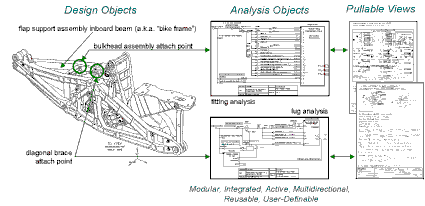Design-Analysis Associativity Technology for PSI
|
|
Sponsor
The Boeing Company - Renton, Washington
Phase 1 (1997-1998)
-
The Product Simulation Integration (PSI) Structures
project is under way in Boeing Commercial Aircraft Group
(BCAG) to reduce costs and cycle time in the design,
analysis, and support of commercial airplanes. The
objective of the PSI project is to define and enhance the
processes, methods, and tools to integrate structural
product simulation with structural product definition.
This includes automated engineering analysis as an
integral component of the product definition. Subprojects
have been defined and working selected topics toward
accomplishing the objectives of the PSI for BCAG
Structures. Formalized integration activities have also
been identified to support the PSI subprojects through
their technology life cycle. [Prather & Amador,
1997]
As part of PSI, Georgia Tech has contributed an information modeling language, termed constrained objects (COBs), that is aimed at next-generation stress analysis tools. COBs combine object and constraint graph techniques to represent engineering concepts in a flexible, modular manner. COBs form the basis of the extended multi-representation architecture (MRA) for analysis integration, which is targeted at environments with high diversity in parts, analyses, and tools [Peak et al. 1998, 1999]. A key MRA distinctive is the support for explicit design-analysis associativity (for automation and knowledge capture) and multidirectional relations (for both design sizing and design checking). Another MRA characteristic is using COBs to represent and manage complex constraint networks that naturally underlie engineering design analysis.
Using a case study approach, lug and fitting design guides have been recast as example reusable COB libraries. The use of these and other COBs on structural parts relevant to the aerospace industry has been demonstrated. These case studies utilize XaiTools, a toolkit implementation of MRA concepts, which interfaces representative design tools (CATIA CAD, materials and fasteners libraries) and general purpose analysis tools (Mathematica solver, ANSYS FEA).
It is anticipated that COBs and the MRA will contribute key technologies to the overall PSI next-generation analysis tool architecture. The potential impact of explicit design-analysis associativity is significant. Capturing such knowledge, which is largely lost today, enables libraries of highly automated analysis modules and provides a precise reusable record of idealization decisions. User adaptation/creation of existing/new analysis templates is also possible.
Today creating views of analysis results such as internal analysis documentation (strength check notes) and regulatory agency summaries typically requires extensive manual effort. While COBs focus on core associativity and analysis computation relations, their combination with technology like XML should enable interactive "pullable views" to help streamline this analysis task. Other COB applications are anticipated, including upstream sizing and inter-analysis associativity.

Phase 2.0 (2000)
Phase 2.0 developed CAD-CAE interoperability roadmaps for a next-generation structures environment. These roadmaps are based on design-analysis integration techniques that support environments with a high diversity of advanced needs.
Target benefits include a) tools that enhance engineering effectiveness by minimizing the CAD-CAE manual data entry gap, and b) increased understanding of next-generation architecture components via concrete capabilities and user experience. Selected templates have been identified as leading edge examples to help achieve a) and b) with subsequent framework versions for increasingly larger sets of capabilities, templates, and users.
Phase 3.0 (2001)
Strength and durability assessments are performed for the structures that airframe companies design, build, deliver, and maintain in order to satisfy regulatory agency requirements and the Design Requirements and Objectives. The information generally required to make these assessments includes, structural geometry, materials, loads, and analysis criteria. One of the traditionally time-consuming and labor-intensive activities in performing these analyses is the extraction and revision of the analysis geometry during the process of evolving the design.
The focus of work in Phase 3.0 has been CAD-CAE interoperability within the context of multi-phase roadmaps. This includes the architecture, methods, and software to demonstrate bi-directional associativity of CATIA geometry parameters with object-oriented analysis templates. This approach builds upon a CAD-CAE interoperability methodology that provides unified techniques for representing and using analysis templates (e.g, constrained objects (COBs) and the multi-representation architecture (MRA). It applies engineering information technology and knowledge-based engineering (KBE) approaches to represent CAD/CAE data and intent in a richer form to better support user needs (including capture of idealization decisions). This methodology provides a foundation to integrate a diversity of design tools and solution methods, enabling enhanced modularity, reusability, automation, and knowledge capture.
Phase 3.0 accomplishments include tool installation at Boeing to better familiarize personnel there with the above current capabilities. A preliminary method, software tool, and examples were also developed to implement idealized features in CATIA v5 and associate them with detailed design objects. This helps users visualize idealized geometry that is automatically scaled based on design geometry, thus providing better understanding and quick visual checking. Bi-directional usage with fine-grained analysis templates is supported, as well as usage scenarios for traditional design-based analysis and promising analysis-based design (which can leverage default or adapted associativity in template libraries). Work to enhance knowledge capture in built-up structure FEA modeling was also initiated.
Overall the COB-based MRA analysis integration methodology helped guide conceptual development of these capabilities and provide increased understanding, thus, supporting progress along the next-generation structures environment solution path.
References
H. Martin Prather, Jr. and Raymond A. Amador (Nov. 17, 1997) Product Simulation Integration for Structures. 1997 MacNeal-Schwendler Corp. Aerospace Users Conference, New Port Beach CA.
R. S. Peak, R. E. Fulton, A. Chandrasekhar, S. Cimtalay, M. A. Hale, D. Koo, L. Ma, A. J. Scholand, D. R. Tamburini, M. W. Wilson (Feb. 2, 1999) Design-Analysis Associativity Technology for PSI, Phase I Report: Pilot Demonstration of STEP-based Stress Templates, Georgia Tech Project E15-647, The Boeing Company Contract W309702.
The Boeing Company (June 14, 2000) Request for Information (RFI): Common Structures Workstation (CSW). and GIT response.
Reports from Phases 2 & 3 - not yet publically available.
R. S. Peak (2003) Characterizing Fine-Grained Associativity Gaps: A Preliminary Study of CAD-CAE Model Interoperability. Paper DETC2003/CIE-48232, ASME Design Engineering Technical Conferences, Chicago.

